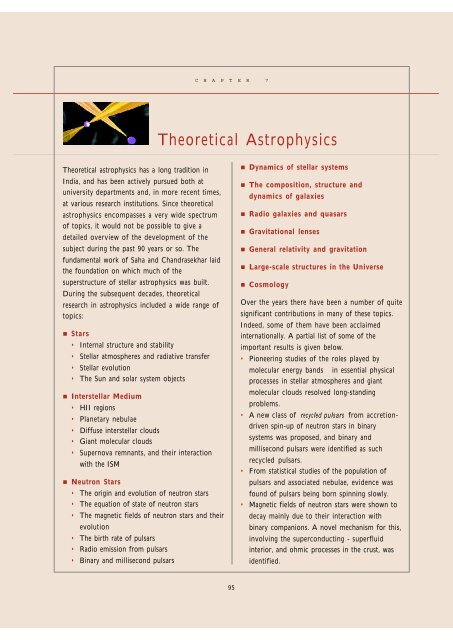2004 ASTRONOMY & ASTROPHYSICS - Indian Academy of Sciences
2004 ASTRONOMY & ASTROPHYSICS - Indian Academy of Sciences
2004 ASTRONOMY & ASTROPHYSICS - Indian Academy of Sciences
You also want an ePaper? Increase the reach of your titles
YUMPU automatically turns print PDFs into web optimized ePapers that Google loves.
CHAPTER 7<br />
Theoretical Astrophysics<br />
Theoretical astrophysics has a long tradition in<br />
India, and has been actively pursued both at<br />
university departments and, in more recent times,<br />
at various research institutions. Since theoretical<br />
astrophysics encompasses a very wide spectrum<br />
<strong>of</strong> topics, it would not be possible to give a<br />
detailed overview <strong>of</strong> the development <strong>of</strong> the<br />
subject during the past 90 years or so. The<br />
fundamental work <strong>of</strong> Saha and Chandrasekhar laid<br />
the foundation on which much <strong>of</strong> the<br />
superstructure <strong>of</strong> stellar astrophysics was built.<br />
During the subsequent decades, theoretical<br />
research in astrophysics included a wide range <strong>of</strong><br />
topics:<br />
• Stars<br />
• Internal structure and stability<br />
• Stellar atmospheres and radiative transfer<br />
• Stellar evolution<br />
• The Sun and solar system objects<br />
• Interstellar Medium<br />
• HII regions<br />
• Planetary nebulae<br />
• Diffuse interstellar clouds<br />
• Giant molecular clouds<br />
• Supernova remnants, and their interaction<br />
with the ISM<br />
• Neutron Stars<br />
• The origin and evolution <strong>of</strong> neutron stars<br />
• The equation <strong>of</strong> state <strong>of</strong> neutron stars<br />
• The magnetic fields <strong>of</strong> neutron stars and their<br />
evolution<br />
• The birth rate <strong>of</strong> pulsars<br />
• Radio emission from pulsars<br />
• Binary and millisecond pulsars<br />
• Dynamics <strong>of</strong> stellar systems<br />
• The composition, structure and<br />
dynamics <strong>of</strong> galaxies<br />
• Radio galaxies and quasars<br />
• Gravitational lenses<br />
• General relativity and gravitation<br />
• Large-scale structures in the Universe<br />
• Cosmology<br />
Over the years there have been a number <strong>of</strong> quite<br />
significant contributions in many <strong>of</strong> these topics.<br />
Indeed, some <strong>of</strong> them have been acclaimed<br />
internationally. A partial list <strong>of</strong> some <strong>of</strong> the<br />
important results is given below.<br />
• Pioneering studies <strong>of</strong> the roles played by<br />
molecular energy bands in essential physical<br />
processes in stellar atmospheres and giant<br />
molecular clouds resolved long-standing<br />
problems.<br />
• A new class <strong>of</strong> recycled pulsars from accretiondriven<br />
spin-up <strong>of</strong> neutron stars in binary<br />
systems was proposed, and binary and<br />
millisecond pulsars were identified as such<br />
recycled pulsars.<br />
• From statistical studies <strong>of</strong> the population <strong>of</strong><br />
pulsars and associated nebulae, evidence was<br />
found <strong>of</strong> pulsars being born spinning slowly.<br />
• Magnetic fields <strong>of</strong> neutron stars were shown to<br />
decay mainly due to their interaction with<br />
binary companions. A novel mechanism for this,<br />
involving the superconducting - superfluid<br />
interior, and ohmic processes in the crust, was<br />
identified.<br />
95
















